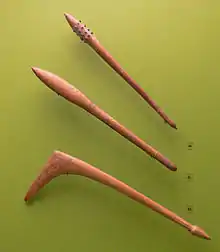Waddy
A waddy, nulla nulla (also written nullah nullah) or hunting stick is an Aboriginal Australian club for use in hunting and fighting. The first of these names comes from the Darug people of Port Jackson, Sydney.[1]

Description and use
A waddy is a heavy, pointed club constructed of carved timber.[2]
Waddies were used in hand-to-hand combat, and were capable of splitting a shield, and killing or stunning prey. In addition to this they could be employed as a projectile as well as used to make fire and make ochre. They found further use in punishing those who broke Aboriginal law, which often involved settling a conflict between individuals, or between an individual and a group, in a trial by ordeal in which fighters gave and suffered heavy blows resulting in skull and bone fractures and much blood.[2]
Construction
They were made by both men and women and could be painted or left unpainted. Their construction varied from tribe to tribe, but they were generally about one metre in length and sometimes had a stone head attached with beeswax and string. They were made from where a branch met the tree, or from a young tree pulled up with its roots from the ground.
Alternative spellings
Waddy has also been spelled as wadi, wady, and waddie. The spelling stabilised around the mid-nineteenth century, partly to help distinguish it from the Arabic word wadi, a dry water course.[1]
References
- Peters, Pam, The Cambridge Australian English Style Guide, Cambridge University Press, 1995, ISBN 0-521-43401-7
- Pardoe, Colin (2014). Violence and Warfare Among Hunter Gathers, M.A. Allen & T.L Jones Ed. Routledge. pp. 117–118.